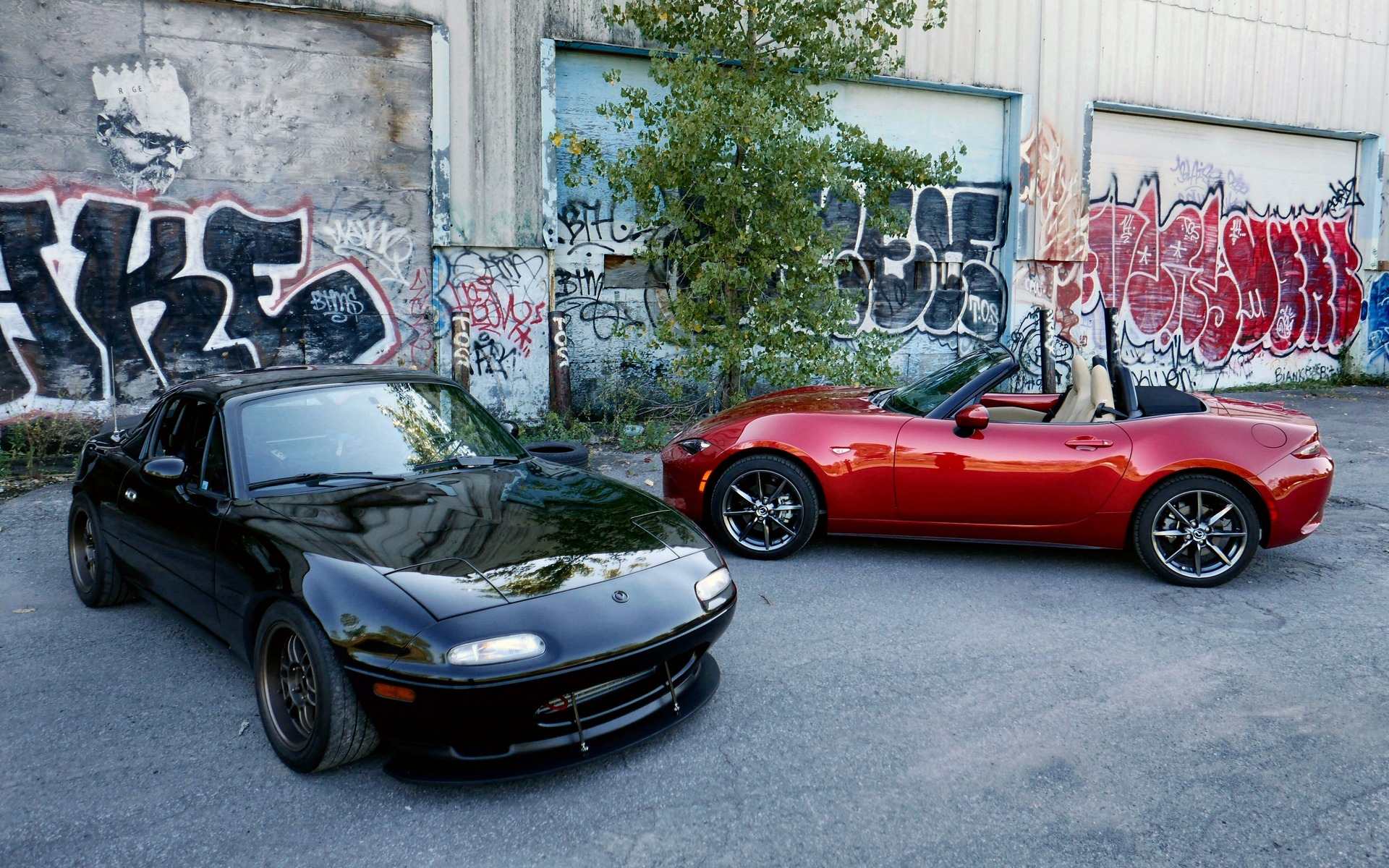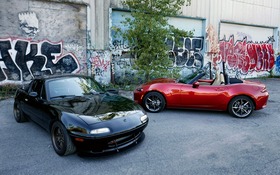What Might Have Been: The 2016 Mazda MX-5 Miata Meets Its 367-Horsepower Grandfather
25 years ago, Mazda introduced the world to its interpretation of the classic British roadster: small, lightweight, and affordable, the MX-5 Miata (also known as the NA) would go on to own the entry-level roadster segment for the next two-and-a-half decades, outlasting nearly every rival even as the sports car segment gradually dwindled down to a shadow of its former self.
Four generations later, it could be argued that Mazda is still building the same car - or rather, has made a valiant attempt to stay true to the original Miata formula while meeting the various fuel efficiency, safety, and packaging requirements inherent in modern automotive design. The 2016 Mazda MX-5 Miata's 155 horsepower, 2.0-litre four-cylinder engine offers a bit more grunt than the 116 horsepower, 1.6-litre mill that ruled the roost from 1990 until 1994 (when a 130 horsepower, 1.8-litre mill was introduced in the first-generation car), but the curb weight of the ND version of the car is nearly identical, an astounding feat given the tendency for bloat that has taken root across the entire industry.
Two Paths Diverged In A Wood
What if Mazda had made a different decision? What if instead of toeing the same line across four design evolutions, the Japanese automaker had instead elected to hone the Miata into a frighteningly quick roadster capable of taking on the best of what the sports car segment has to offer? Had Mazda elected to explore the very limits of the Miata platform, how different might the MX-5 experience be today?
Fortunately we don't have to wonder, because there's a thriving community of Miata tuners and enthusiasts who have stepped in to fork the road and head in the direction Mazda discretely declined all those years ago. My encounter with a very special first-generation car recently proved to me that there was far more performance potential locked up inside the original MX-5 than most of us ever dreamed possible.
Fraternal Twins
Adam Miller's 1997 Mazda Miata represents the final result for the roadster's initial run, with Mazda skipping the 98 model year in favour of what would become known as the NB redesign in 1999. If you've ever wondered the best way to make the 2016 edition of the Miata look big, the answer is simple: park it beside an NA. Side-by-side, but especially in profile, the effects of European pedestrian safety regulations on automotive design become clear. The current Miata's flat front end contrasts to the downward slope of the 97's hood, a feature emphasized by the hide-away headlamps long since done-in by similar regulations. The coilovers on Miller's car don't do the stock ride height ND any favours, but it's apparent from the wheel gap that the 2016 car emphasizes comfort over centre of gravity - not a concern when seeking out the best cornering grip in a more dedicated performance model.
The Cerebral Assassin
Pop the hood of Miller's Miata and you'll see the same 1.8-litre motor that it came with from the factory. Of course, it's not alone: there's also a Garret turbocharger plumbed in to overcome the four-cylinder unit's small displacement by forcing as many atmospheres as possible through its intake. If you were to crack open the block you'd find forged pistons and rods, a necessity to accommodate the 367 ponies that this tiny engine is putting down to the rear wheels - in effect tripling the crank horsepower of the stock motor and beating the 2016 Miata by more than 250 horses as measured on a dyno. Squeezing that much power out of the stock-block Miata motor required an extensive amount of data logging and analysis on Miller's part, but his tune is suitable for street use and the car's boost controller allows you to dial in whether you want crazy, insane, or certified lunatic levels of acceleration.
Dramatically Different Experiences
The 2016 Mazda MX-5 Miata is an extremely easy car to drive within its very accessible performance envelope. Floor it through the first three gears and you're still within the realm of explaining yourself out of a speeding ticket should you attract the attention of the local constabulary. Keep the pedal pinned in Miller's NA, and if you have any rubber left on the tires after the shift into second you'll probably need a parachute to stop within the same county as the officer who lit you up a quarter-mile back. Then there's the sound: the turbocharged car's restriction-free exhaust provides a running commentary on engine RPM, without the need for the sound-enhancing intake pipe running through the firewall of the naturally-aspirated car (to sweeten its much quieter tailpipe emissions).
Given that both of these vehicles weigh roughly 2,500 lbs (depending on how you choose to equip the ND), the rear-wheel drive platform underpinning each provides exceptional handling compared to heavier sports cars. There are still important differences between the two models, however. The 1997 Miata's manual steering rack offers exceptional feedback and requires quite a bit of effort at low speeds; the 2016 MX-5's electrically-assisted system erases most of the pavement passing underneath the car's front wheels. The stiff suspension on the modified NA brooks no roll through a series of apexes, while the ND pitches from side to side, not uncontrollably but enough to let you know you're exercising the car. There's also an extra forward cog in the 2016's six-speed manual transmission, besting the five-speed box (sourced from an RX-7) found in the older car.
Oh, and it's a heck of a lot easier to access the 2016 Mazda Miata's open-top cockpit, as compared to the hardtop-installed 1997 edition, especially considering the side impact bars attached to the Miata's roll bar. The ND's creature comforts and roomier cabin are a contrast to the more purpose-built feel of Miller's machine, but a lineage of simple gauge displays and affordable plastics links the two cabins.
What Might Have Been
Why didn’t Mazda fund the development of a Miata-based barn burner? I can think of a few reasons. At the time of the NA's release, Mazda was dealing with exceptionally slow sales of the final generation of RX-7 to reach North American shores, indicating that perhaps the market for high tech performance cars was starting to cool (a fact later confirmed by a general lack of interest in the Mazdaspeed turbo edition of the NB). Then there's the financial issues that the company later struggled with, and the choice it made to emphasize fuel efficiency and handling over outright speed and braggadocio in most of its production models - a move that saw Mazda emerge from the red more financially stable than ever.
In maintaining the status quo with the 2016 Mazda MX-5 Miata (at least conceptually) it could be argued that the automaker has made the 'smart' decision, especially with coupe and convertible sales hovering near historic lows. The new Miata is definitely fun to drive, and if not as affordable as it once was (its now a near-luxury product in the Canadian market), it's still a far cry from the price of a Corvette. Still, there's no doubt in my mind that concealed in the DNA of the MX-5 Miata is the blueprint for a world-beating sports car.
The fact that Miller's home-built, daily-driven first-generation version of the Miata can wipe the floor with a modern Stingray Corvette in a straight line and hang with a Porsche 911 GT3 on a road course indicates how much potential is concealed within the car's endlessly-tunable chassis and surprisingly robust BP 1.8-litre motor. Imagine what the current generation of tuners could do with Mazda's millions, the ND platform, and an entire R&D department at their disposal?












